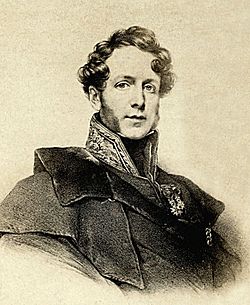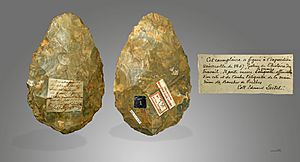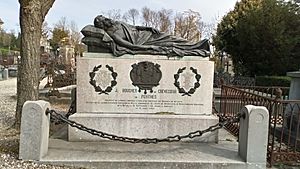Jacques Boucher de Crèvecœur de Perthes facts for kids
Quick facts for kids
Jacques Boucher de Crèvecœur de Perthes
|
|
|---|---|
 |
|
| Born | 10 September 1788 |
| Died | 5 August 1868 (aged 79) Abbeville, France
|
| Nationality | French |
| Known for | flint tools in the gravels of the Somme valley |
| Scientific career | |
| Fields | archaeology |
Jacques Boucher de Crèvecœur de Perthes (French pronunciation: [ʒak buʃe d(ə) kʁɛvkœʁ də pɛʁt]; 10 September 1788 – 5 August 1868) was a French archaeologist. He is famous for discovering ancient stone tools in the gravels of the Somme valley in France around 1830. His work helped prove that humans lived much, much longer ago than people previously thought.
Contents
Life and Early Career

Jacques Boucher de Perthes was born in Rethel, France, in 1788. His father, Jules Armand Guillaume Boucher de Crèvecœur, was a botanist and worked for the customs office. In 1818, Jacques was allowed to add his mother's last name, de Perthes, to his own.
In 1802, when he was 14, Jacques started working for the government in customs. He spent six years working in Italy. After returning to France in 1811, he quickly got promoted. In 1825, he took over his father's job as the director of the customs office in Abbeville. He stayed there for the rest of his life.
Discovering Ancient Human Tools
Boucher de Perthes spent his free time studying very old human history. He was especially interested in what we now call the Stone Age. Around 1830, he found some flints in the gravels of the Somme valley. He believed these flints were shaped by human hands.
However, it took many years for him to share his important discovery. In 1846, he finally announced that he had found a worked flint tool. It was found with bones of ancient animals like elephants and rhinoceroses in the Menchecourt area.
Publishing His Findings
In 1847, Boucher de Perthes began publishing his huge three-volume book, Antiquités celtiques et antédiluviennes. In this book, he was the first to clearly state that humans lived during the Pleistocene period. This period is also known as the early Quaternary period, which was a very long time ago.
At first, many people did not believe his ideas. This was partly because he had made some claims about ancient humans before without strong evidence. Also, the drawings of the flints in his book were not very clear.
Gaining Support for His Ideas
Things started to change in 1855 when Dr. Marcel Jérôme Rigollot from Amiens strongly supported the idea that the flint tools were real. But it wasn't until 1858 that a scientist named Hugh Falconer saw Boucher de Perthes' collection in Abbeville. Falconer then convinced another important scientist, Sir Joseph Prestwich, to visit the site the next year.
Prestwich carefully examined the tools and the ground where they were found. He finally agreed that the flint tools were made by humans. He also confirmed that they were found in undisturbed ground, alongside the bones of animals that had been extinct for a very long time.
Another famous scientist, Charles Lyell, also supported Boucher de Perthes' findings. Lyell confirmed that the layers of earth were incredibly old. He also suggested that the chalk lands of Picardy, France, were once connected to England. He explained that the Strait of Dover was formed by very slow erosion over a long time.
The Moulin-Quignon Jaw Incident
In 1863, Boucher de Perthes found a human jawbone along with worked flints in a gravel pit near Abbeville. This seemed to fully prove his ideas. However, there was some doubt about how old the jawbone really was. It was possible it had been buried there more recently.
It turned out that the "Moulin-Quignon jaw" was a trick. One of Boucher de Perthes' workers had planted it there. The worker did this because Boucher de Perthes had offered a reward for finding human remains. Even though the jaw was a hoax, people still believed in Boucher de Perthes' honesty. He was even made an officer of the Légion d'honneur, a high French award, that same year.
His Legacy
Even though Boucher de Perthes was the first to show that early humans lived in Europe, he couldn't say exactly when. The scientific tools and knowledge to figure out precise dates didn't exist yet. Today, we know that the hand axes found in the Somme River area are at least 500,000 years old. Many scientists believe they were made by Neanderthals. Some even think they could be a million years old and were made by Homo erectus.
Other Interests
Boucher de Perthes was interested in many things besides archaeology. For over 30 years, he was the president of the Société d'Emulation in Abbeville. He wrote many articles for their publications on various topics. He also wrote plays, fiction books, travel stories, and books about money and helping people.
After His Death
In 1954, the Museum Boucher de Perthes opened in Abbeville. It has many different collections, including some of his archaeological finds.
The famous writer Jules Verne even mentioned Boucher de Perthes in his novel Journey to the Centre of the Earth (1864). In the story, characters find "antediluvian" (pre-Flood) human heads, and Boucher de Perthes is referenced.
See also
 In Spanish: Jacques Boucher de Perthes para niños
In Spanish: Jacques Boucher de Perthes para niños
- Thunderstone (folklore)
Images for kids



